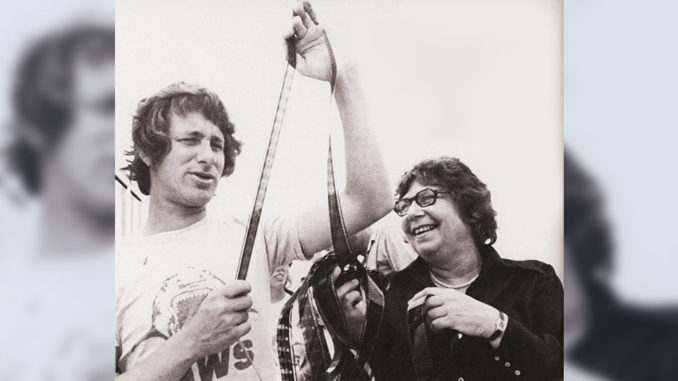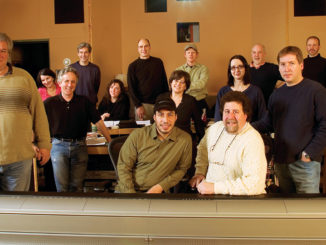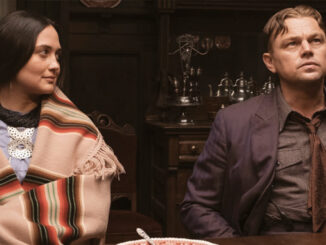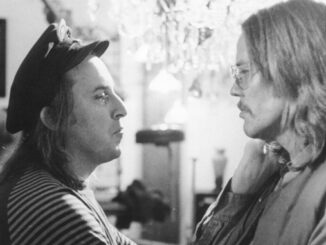
What is film editing? Good film editing? Great film editing?
James Clark: a) Taking a pile of uncut rushes and sticking them together in a manner which reflects the intentions of the director. b)…which goes unnoticed. c)…which goes unnoticed by even other film editors.
Antony Gibbs: Film editing is putting into dramatic form the basic filmed material given to the editor by the director. Good editing is the total interpretation of the director’s and writer’s intentions. Great film editing is taking their intentions even farther and showing them a dimension to their project which even they may not have imagined to be there.
Reginald Mills: a) Timing. b) Good timing. c) Perfect timing.
Anthony Harvey: a) Would take many pages. b) Putting together the puzzle. c) Putting together the puzzle correctly.
Claudine Bouché: Film editing is putting rushes harmoniously together in order to tell a story. Good film editing is giving to the rushes a special atmosphere, being true to the script, trying to hide shooting weaknesses or script weaknesses, if any. Great film editing must not show on the screen but is a heartbeat.
Henri Colpi: a) A whole book cannot explain. b) That depends on the film, on its scenario, on its direction. c) To begin with, it must have been a great film, conceived in terms of editing.
“I work by osmosis, through intuition and enthusiasm.” – James Clark
Agnès Guillemot: a) Rhythm and music. Organization of a form resembling an orchestra. b) Good film editing is when the film breathes well. c) Great film editing is when the entire being is happy.
Verna Fields: The answer to all three: whatever makes the picture work. Sound cutters make the best editors [sound more than music editors] because they have a feeling for rhythm and pace necessary to make something work. They can make things work by manipulating within the picture without changing the picture.
Barbara McLean: Film editing is telling the story with film. Good film editing is selecting the best of the film. Great film editing occurs when you begin with great pictures.
William Reynolds: Film editing is the assembling of filmed material into a coherent entity. Good film editing is accomplishing the above in superior fashion. I suppose great film editing involves accomplishing the above in such superior fashion that the whole far surpasses the sum of its parts.
Ralph Rosenblum: No way of knowing, unless one has knowledge of the script and the film photographed. All editing is invisible.
Margaret Booth: Rhythm counts so much; the pauses count so much. Everything must be rhythmic. It’s the same as when people speak or dance; you can tell right away when it’s wrong. Everything has to be rhythmic.
“My experience in vaudeville enabled me to observe audiences and to learn from them, how they react to situations.” – Daniel Mandell
Is there such a thing as an editing “style,” making it possible to identify the work of a particular editor?
James Clark: The editor alters style according to subject and director, becoming the director’s alter ego, helping to “remake” the film in the cutting room.
Antony Gibbs: I prefer to say “handwriting,” which can mature as the years go by. An editor should devise a style for the subject.
Reginald Mills: I do not believe that this is possible. If a film is well edited, one is never aware of cutting from one shot to another.
Tom Priestly: Style must vary from subject to subject unless it is blandly imposed regardless of the material. The cliché about sculpture that the sculptor merely finds the statue which is waiting in the stone applies equally to editing: the editor finds the film which is waiting hidden in the material.
John Victor-Smith: I think that editing style can only be applied to a particular director’s work, and may not necessarily be the work of the same editor.
Henri Colpi: I believe that I can defy anyone to recognize an editor from a film. Except, of course, if the editor is the master of the film, if the film only exists as a work of editing.
Agnès Guillemot: It is possible to recognize the “footprint” of an editor as it is that of an orchestra conductor of a musical work. But the editor must embrace the personal rhythm of each director and not impose her own.
“I suppose when the French New Wave decided that people no longer had to walk in and out of doors, this was an important change.” – John Victor-Smith
Rudi Fehr: In my humble opinion, absolutely not!
Do you yourself have a discernible style as an editor? What are its characteristics?
James Clark: I work by osmosis, through intuition and enthusiasm.
Antony Gibbs: A use of extreme long shot with dialogue over. Breaking up the rhythm of a long dialogue scene, bringing it almost to a halt and then starting the rhythm again. The deliberate use of unrhythmic cuts to create nervousness, putting the cuts and the compositions in the unexpected place to the same end, and also to enhance the effect of a juxtaposed scene cut in the traditional manner, etc.
Reginald Mills: I hope not. I just strive for perfection of timing.
Ernest Walter: I believe in tying cuts together within a scene by overlapping the soundtrack. Again, within a sequence, some will never cut to closer angles along a straight line without throwing in a reverse cut first. If I find it effective to jump straight in, then I will do so, and I tend to do it frequently for effect.
Anthony Harvey: Austerity—I hate tricks.
Henri Colpi: Since I am more a director than an editor, I might say that there is in my films a style of direction, which is encountered on the level of editing. The best sequences of my films closely ally direction and editing: that is, poetry and rhythm.
“Practically everything considered new was originally used by Griffith, Eisenstein or Abel Gance.” – Bernard Gribble
Angès Guillemot: My ambitions as to style are: rigorousness, precision, humility, simplicity.
Verna Fields: I don’t cut comedy any differently than drama. You have to reach for emotion and that is done the same way, regardless of the emotion.
What has been the most important influence on the development of your craft as an editor?
James Clark: Documentary. As a child, I was exposed to the films of Grierson, Flaherty, Wright, Watt, Jennings and many others. It was the interpretation of realism or “heightened realism” that first turned me on to film and made me want to cut it… I was also much influenced by the British comedies directed by Walter Forde and Marcel Varnel—perhaps not for the best. The greatest influence on my life was the love of music, which gave me a sense of rhythm and timing, essential to my work.
Antony Gibbs: Most important was meeting Tony Richardson at the height of his powers. Knowing nothing of the technicalities of film editing, he pushed me further away from convention than I would have dared go alone. In a similar way, Richard Lester lost me my final inhibitions, but the technique and use of optical effects was made more prominent.
Bernard Gribble: The speed of Frank Capra’s films was an early inspiration. Study of Louis Loeffler’s editing of Laura was very instructive. Oswald Hafenrichter’s work on The Third Man opened up new possibilities, as did William Hornbeck’s work on A Place in the Sun. Perhaps the greatest influence was the revolutionary style of thought editing pioneered in Hiroshima, mon Amour, although practically everything considered new was originally used by Griffith, Eisenstein or Abel Gance.
Ernest Walter: I would say there have been two main influences: 1) The good director who provides enough material to allow total flexibility—for his ideas, and for his tenacity. 2) The poor director, who provides indifferent material and often not enough of it. Here the editor’s left with only one way to go—to pull something out of the bag.
Anthony Harvey: a) My first year with the Boulting Brothers, editing Private’s Progress. b) Working with Kubrick.
“The greatest transformation in the editing of the films of the Sixties was brought about by Jean-Luc Godard. He found a new continuity in the manner of telling a story in time by utilizing ellipses in the editing of the images.” – Renée Claude Lichtig
Claudine Bouché: 1) Working with François Truffaut, who writes the script as well as directs the picture. In such a case, the “montage” after shooting is not only cutting but sometimes rewriting the story, changing the continuity of the sequences, giving importance to a character, etc. 2) I had a chance to see Hitchcock’s pictures, again and again, on a Moviola.
Henri Colpi: 1) Eisenstein. 2) Orson Welles. 3) Willy Zielke. 4) Murnau. In my own case, I cannot separate influences on editing from those on direction, so all of these equally as directors as well as editors.
Henri Lanoe: Having seen Potemkin and having worked with Alain Resnais and Henri Colpi.
Renée Claude Lichtig: I had the opportunity to view (and thus to study) thousands of films at the Cinematheque Francaise under the direction of Henri Langlois.
Verna Fields: The most important influences on me have come from people and their work—writers, directors, art directors, costume designers. Director Irving Lerner had a great influence on me. I worked under him on El Cid. He recommended me to Bog-danovich for Targets.
Daniel Mandell: My experience in vaudeville enabled me to observe audiences and to learn from them, how they react to situations.
Ralph Rosenblum: The single most important influence has been the appreciation of, love for, and knowledge of music.
Elmo Williams: Working with Merrill White, because he taught me to experiment and to keep trying.
What do you consider to have been the most important changes that have occurred in film editing since 1960?
Antony Gibbs: After the beautiful madness of the Sixties, the lessons of the nouvelle vague have been learned and absorbed. The best of that period is now with us in our filmmaking and the worst has been discarded. We are surer in our profession and no longer inhibited about direct reverses and armies marching left to right.
“Film editing is putting into dramatic form the basic filmed material given to the editor by the director. Good editing is the total interpretation of the director’s and writer’s intentions. Great film editing is taking their intentions even farther and showing them a dimension to their project which even they may not have imagined to be there.” – Antony Gibbs
Reginald Mills: A steep decline in the art of film editing due firstly to the bad influence of instant television editing and, secondly, to the lack of dedication in would-be and established editors.
John Victor-Smith: I suppose when the French New Wave decided that people no longer had to walk in and out of doors, this was an important change.
Claudine Bouché: 1) More freedom in cutting the picture itself. 2) The place and prominence of the music. Old films had music from beginning to end, which made the music look more like a sound effect. Less music nowadays, more efficient. Less sound effects, too, but important ones. No more process shots.
Agnès Guillemot: The great change brought about by the New Wave in France (though Gremillon and Vigo had already prepared it) is the construction of films more according to a rhythm than according to realism of the anecdotal narrative.
Renée Claude Lichtig: The greatest transformation in the editing of the films of the Sixties was brought about by Jean-Luc Godard. He found a new continuity in the manner of telling a story in time by utilizing ellipses in the editing of the images. These changes took place after the first films of Godard. He influenced the filmmakers of the whole world.
Verna Fields: The butt splicer. Irving Lerner has said, “The butt splicer freed the editor.” Its use allows you to try something, and if it doesn’t work, to go back and make even the most minute change. Or just to try different possibilities for cuts.
Daniel Mandell: I believe film editing has not improved. It has deteriorated since the advent of television.
Ralph Rosenblum: Since the Beatles films, technique has taken over. Editing has become flamboyant solely for its own sake. or to cover deficiencies in writing and directing. When the editing of a film is the only memorable quality, the film most likely is forgettable.
To help us celebrate the 70th anniversary of the Motion Picture Editors Guild, our colleagues at the prestigious film journal Film Comment in New York have allowed us to reprint copy from their special 24-page section celebrating film editors––“Prime Cut”––which appeared in the March-April 1977 issue. While the bulk of their salute was a semi-exhaustive list of filmographies of the top 75 editors (Film Comment’s selection) from the United States, Great Britain and France, we decided to forego that element, since it only covered up to 1977––and besides, those credits are readily available today on IMDb. We retained their 75 choices, however, as well as other parts of their section: editors’ answers to questions about editing techniques and their best work, and an interview with Robert Wise about cutting Citizen Kane.
So, beginning above and continuing in the articles “Top 75 Picture Editors“, “My Best Work“, “Prime Cut” and “As the Editor, You’re the Audience” , everything––save for some photos, captions and headlines––is the work of the Film Comment team from 1977. Special thanks to our writer Kevin Lewis and especially Film Comment’s Sayre Maxfield (who is still with the publication today) for making all of this happen. – The Editor





